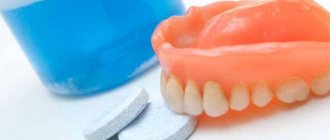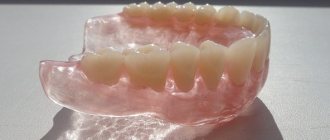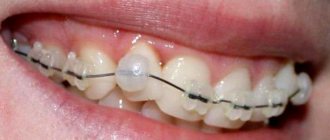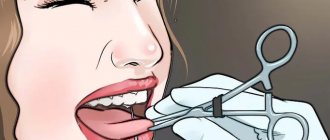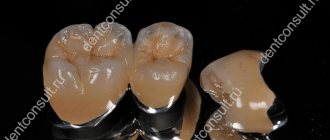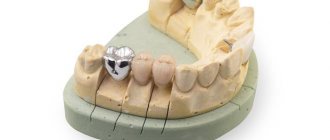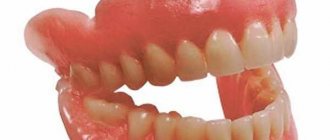Why is it more difficult to get used to a complete removable denture on the lower jaw?
The upper complete removable denture, due to its shape and anatomical features of the upper jaw, sticks to the palate and holds quite well.
People have little trouble fixing it. The greatest difficulty in getting used to is the lower complete removable denture. This is due to the fact that when not a single tooth is missing, there is a difficult fixation of this prosthesis on the lower jaw. The lower complete removable denture cannot adhere to the lower jaw, it simply lies on it.
The situation is further aggravated by the fact that the tongue is attached to the lower jaw. As the jaw moves, this powerful muscle begins to move and releases the denture. The masticatory muscles are also attached to the lower jaw, which at the moment of chewing also begin to move, move the mucous membrane and try to remove the denture. In addition, the anatomical complexity of the mucous membrane on the lower jaw complicates the adaptation and fixation of a removable denture, since it is looser, softer and less attached to the bone compared to the upper jaw.
What affects the quality of fixation of dentures in the oral cavity?
No matter how high-quality the removable appliance is initially, its functionality after installation is measured by the comfort of wearing for the patient and the ability to replace lost teeth as much as possible, restore chewing function and aesthetics of the row.
PROSTHETICS WITH 6 OSSTEM IMPLANTS FROM RUB 200,000.
Complex implantation Osstem (South Korea) with delayed loading after 4-6 months.
Call now or request a call
What affects the fixation of dentures? There are factors that influence the fixation and position of artificial devices in the oral cavity, which must be taken into account when creating a design:
- anatomical features (“relief”) of the alveolar ridge, palate and prosthetic bed. The vertical shape of the gums is more conducive to retaining the structure than flat, mushroom-shaped or sharp ones.
- interaction of the apparatus when chewing with the inside of the cheeks, lips, their holding ability or, conversely, the possibility of displacement during muscle movement,
- the position, size and mobility of the tongue, under which a bed is formed in mandibular complete dentures. The tongue can also both hold the structure in place and move it,
- uniform distribution of load on the bed,
- absence of pre-contacts: the teeth of one side of the device should not come into contact with the opposite ones before the other side. In this case, the device cannot tip over,
- correct position of artificial teeth along the axis.
The quality of fixation and stabilization of removable dentures determines the effectiveness of orthopedic treatment1. Experts evaluate the quality of fixation using the Ulitovsky-Leontiev index, which describes more than 10 fastening parameters.
What to do if the denture rubs the gums?
If the prosthesis begins to rub the gums, pain and discomfort begin, you need to evaluate how intense this pain reaction is.
If these are minor pain sensations: it hurts a little, aches a little, tingles, then you can wait 2-3 days, using pharmacy ointments for pain.
If these sensations do not go away within 2-3 days, or the pain intensifies, then you need to go to the doctor who made this removable denture. The doctor will look at your jaw and in those places where the prosthesis presses too much, he will adjust it and sharpen it so that in this place the prosthesis does not press through the mucous membrane. There may be one or several such corrections, depending on the sensitivity of the patient’s mucosa. Over time, these corrections stretch from one to two to three weeks.
Why is crown removal necessary?
The average lifespan of a standard crown that covers a natural tooth is about seven years. If the crown is installed on an implant, then it may well last for fifteen years. As a rule, the removal of a crown from a tooth is carried out for a number of reasons.
- Errors during prosthetics. Most often, the fault lies with specialists who made a mistake at one of the stages of treatment. Incorrect manufacturing of the product, incorrect calculations at the preparatory stage, the use of low-quality materials - all this leads to the fact that the prosthesis cannot function properly and has to be removed.
- Injuries and mechanical damage, after which further use of the dental crown becomes impossible.
- Diseases developing under the crown. Secondary caries, periodontitis, cysts are complications in which tooth treatment without removing the crown is almost impossible.
- Gum diseases requiring removal of the denture for treatment procedures.
- Expiration date. Each crown has its own lifespan (especially when installed on a natural tooth). If a crown has lost its functional and aesthetic qualities over time, it must be replaced. Often the crown falls out on its own due to damage or destruction of the bonding agent.
- The desire of the patient himself. For example, in order to replace an old metal or metal-ceramic structure with a more modern and aesthetic product.
Dangerous symptoms!
- Constant pain under the crown indicates the development of an inflammatory process and the need for re-treatment.
- Unpleasant odor concentrated in the crown area. It usually occurs due to the decomposition of tissue under the crown or the ingress of food particles, which indicates a violation of the seal.
- The crown becomes mobile. This is due to decay of the tooth or dental cement under the crown.
If you experience the above symptoms in one form or another, we advise you to contact your dentist as soon as possible. After taking an x-ray, it will become clear whether you have a hidden problem and whether the crown needs to be removed.
Correction, relining of a removable denture when the gums are rubbing.
If chafing from a new denture does not go away and you decide to see a doctor, then it is necessary that these chafing be visible to the doctor. That is, if you removed the denture and did not wear it for some time, then before visiting the doctor you need to wear the denture for several hours so that all the rubbing, redness, and calluses on the gums appear again, and the doctor can see the places on the gums that the denture is pressing through. Otherwise, if the doctor does not see anything on the gum, the denture is sawed at random and a lot of excess is cut off, which further worsens the fixation of the complete removable denture, and food will accumulate and get stuck in these places when eating.
Parting words
Remember that removable dentures will help you restore the aesthetic qualities of your teeth, as well as chewing food. Consider this design as an integral part of your health. Use them and regularly care for your dentures, following the recommendations above.
The following article describes the care of structures supported by implants.
Orthopedic dentist Dmitry Viktorovich Martynov
Favorites
…
How can I make it easier for myself to adapt and get used to a lower removable denture?
If the denture is very poorly fixed on the jaw and dangles, if the jaw is flat and there is nothing for the denture to grab onto, then you can use special means to improve the fixation of the removable denture. These are various adhesives and gaskets.
Many patients do not wear their dentures all the time, and they especially often take them out at night. There is no such need; to get used to it, it is better to wear the prosthesis around the clock. Nothing bad can happen at night, the prosthesis simply cannot be swallowed or choked on, it is much larger than a person’s throat. In the worst case scenario, you may wake up and the denture is not in your mouth, but lying next to you on the pillow. You shouldn’t take breaks during the day either, even if your jaw and gums are tired, you want to rest. At this moment, when you remove the prosthesis, the jaw and mucous membranes become unaccustomed to the prosthesis, and when an hour later you put it on again, everything starts all over again. At the same time, the jaw and mucous membranes become even more tired. Often, patients who take breaks simply stop wearing such a prosthesis after a few days.
Frequently asked questions from readers
How to put on dentures correctly?
The doctor will tell you about the technique of installing dentures in the mouth, he will also ask you to repeat the steps and, if necessary, make adjustments. In the future you will have to do this yourself. To make the task easier, follow the recommendations:
- Training in front of a mirror will help you develop the skill.
- After installation, try opening and closing your mouth several times, moving your jaws to the right and left.
- Do not remove the product at night, this will speed up the adaptation process.
How to quickly get used to dentures?
Here is a detailed article on this topic
The speed of adaptation largely depends on how responsibly the patient treats the adaptation process. Several recommendations will shorten and facilitate the adaptation period:
- Give preference to soft foods so that the mucous membrane adapts to chewing loads.
- Massage your gums. It normalizes blood circulation and reduces pain. To do this, place your index finger on the outside of the gum and your thumb on the inside. Gently rub your gums, pressing lightly on them. The procedure, which lasts 10 minutes, must be repeated several times a day.
- Do preventive rinses with sage or chamomile solutions. They will help prevent inflammation and disinfect injured tissue.
- Learn breathing techniques through your nose to combat your gag reflex.
- For the first 7-10 days, leave the structure in your mouth while you sleep.
- Drink more water to help relieve dry mouth.
For the first time, practice putting on your prosthesis in front of a mirror.
Usually it takes 1-3 months for complete adaptation, but in some cases this period can last up to a year.
Storage rules
Previously, rubber was used as the main material for the manufacture of prostheses. It cracked in the air, so the structures were stored exclusively in a glass of water. Now that more modern materials are used, there are no such strict requirements. However, doctors recommend storing products in a humid environment - water or a special disinfectant solution. The rules are simple:
- The solution should not contain chlorine (chlorine is especially harmful for metal parts).
- Water temperature is room temperature.
- When lowered into hot water, the product becomes deformed.
Most doctors agree that modern models do not need to be taken out at night. It is enough to clean them thoroughly before going to bed and reinstall them in the oral cavity.
Use a special box to store the prosthesis
Individual intolerance to dentures
Intolerance is indicated when the following symptoms appear:
- burning or itching of the mucous membrane;
- pain, local or deep;
- appearance of foreign tastes (metal, plastic);
- the occurrence of erythremas and ulcers.
The most common causes of intolerance:
- allergic reactions;
- toxicity of the materials used;
- mechanical irritations;
- general immune diseases;
- psychological factors.
Most often, in such cases, it is necessary to manufacture a new structure using materials that do not cause such reactions. But the doctor can send the patient for a consultation with specialized specialists - for example, a psychotherapist or an immunologist.
Purchase special brushes, pastes, and disinfectant solutions for prosthesis care.
Rules of care
Hygiene is one of the main conditions for quickly getting used to dentures. Care involves following several rules:
- After each meal, the structure must be rinsed. Those who wear removable dentures should remove them and wash them under running water.
- In the morning and evening, clean the products with a soft brush and paste that does not contain abrasive substances.
- Orthopedic systems require additional disinfection. For this, special products are used, usually available in the form of tablets, soluble in water. The prosthesis is placed in this solution for 15 minutes, the procedure is carried out 1-2 times a week.
Is it possible to whiten dentures?
Orthopedic systems tend to darken over time, especially if they are made of acrylic. Even after thorough polishing, it remains rough; a coating appears on the surface, easily absorbing any dyes. There are several methods of whitening:
- Mechanical cleaning with special brushes designed for dentures, which are sold in pharmacies. It is not recommended to use abrasive bleaching pastes: the particles they contain will damage the surface.
- Ultrasonic cleaning in a clinic is a prerequisite for proper product care. It must be carried out at least once a year.
- The use of special solutions, for the preparation of which soluble tablets are produced. They work through an antiseptic effect, disinfecting the surface, but do not remove stubborn plaque.
Should I rent it at night?
At night, orthopedic structures can be removed and stored in a humid environment to avoid drying out. However, during the first week you should sleep with them to speed up the addiction. At the same time, it is important not to forget that before going to bed and after waking up, the products must be removed and thoroughly cleaned.
You should not endure prolonged discomfort or acute pain. As a rule, they signal that the structure was manufactured and installed with violations, without taking into account some individual characteristics. In this case, only an orthopedist can help, who will make the necessary adjustments.
How do you know if it’s time to change the crown or if it can still serve?
There are objective signs that reflect the condition of crowns/bridges, which are assessed by an orthopedic dentist during a routine examination:
- service life of the crown/prosthesis
- patient complaints (pain, food getting stuck near the crown, unpleasant odor near the crown, and others)
- fit of the crown to the tooth (marginal fit)
- the presence of areas of plaque accumulation
- condition of the gums next to the crown (color, bleeding, density, presence of other signs of inflammation, raising the edge of the gums (exposure of the root))
- presence of signs of inflammation of the bone tissue around the tooth with a crown
- density of interdental contact (crowns with adjacent teeth).
If one or a number of signs are present, the doctor decides whether the crown needs to be replaced.
What determines the service life of a crown?
- The service life and the need to replace the structure greatly depend on the accuracy of manufacturing at all stages. Precision work means that the crown fits to the tooth without gaps, without steps, without voids, oral fluid and food do not get under it, the gums around it do not become inflamed, it is no different from the “native” tooth. It is the precision of manufacturing that determines the quality of work, and therefore is the key to a long service life of the crown. For example, I had to deal with a situation where the crown was made only a year ago, and upon examination, strict indications for its urgent replacement were revealed (due to poor quality, namely inaccurate manufacturing). And vice versa, when examined, the crown meets all the requirements, all parameters are normal, there is no need to replace it, and it has been standing for 10 years (which means it was manufactured very accurately and in a timely manner).
- We have repeatedly mentioned that accuracy, and therefore quality, is at the forefront. If we take quality as a given, then the material and method of fixation come to the fore. So, the service life also depends on the material from which the crown is made and, accordingly, on the method of fixing it to the tooth . Classic metal-ceramics and zirconium dioxide-based crowns are attached to a special “cement,” that is, an intermediary between the crown and the tooth, and do not enter into a “chemical” bond with either this cement or the ground tooth. Namely, this cement is “destroyed” and “washed out” over time, leading to a violation of the seal of the entire structure. Crowns based on lithium disilicate (also called “E-max”) are fixed without an intermediary: using the adhesive (“glue”) method, that is, they are glued to the tooth tissue, which leads to a very strong connection between the crown and the tooth. Accordingly, the service life of such structures is longer than the 5-7 years described above, which means that a crown change will not be required soon.
- In addition, the service life is greatly influenced by the condition of the tooth for which the crown was made. If a patient hesitates for a long time to adequately restore a damaged tooth, he comes for prosthetics at an untimely rate, in particular when the tooth is destroyed by a carious process to the level or below the level of the gum, becoming “soft” and unreliable. In such conditions, the doctor is no longer able to make an accurate marginal fit; such a structure will never be completely sealed, which means the tooth under such a crown will be destroyed. In such conditions, neither good materials nor the method of fixing the crown will help. And if the doctor nevertheless undertakes the restoration of such a tooth, this will be the last crown on it, since it will be impossible to repeat the restoration.
Important! Dear patients, do not delay the restoration of damaged teeth, do not deprive yourself of the opportunity to save your own tooth faster, more reliably and cheaper!
By clicking on the “Make an appointment” button, I consent to the processing of my personal data.
I have read and agree with the conditions for processing personal data set out on the website ds-chocolate.ru.
Consent to the processing of personal data
Clasp dentures
One of the modern and effective methods of dental prosthetics in the upper jaw . At its base there is a metal arc, which provides strength and allows the base area to be reduced.
Clasp dentures There are three types of fixation: clasp, lock and telescopic crowns.
The first one does not damage the enamel and does not require preparation, but in some cases the clasps can be noticeable in the oral cavity. Locking fixation, although it requires the manufacture of crowns for supports, guarantees more effective and reliable fastening of the prosthesis, as well as high aesthetics. The telescopic method involves the manufacture of crowns on abutment teeth and, like a locking one, allows you to securely secure the clasp in the oral cavity. Another advantage is the significantly smaller volume and thickness of the base and it often does not overlap the sky.
Bottom line: how long does it take to replace crowns?
According to the book rules : in 5-7 years.
It is better to replace poorly made crowns immediately after placement, so that the teeth underneath do not deteriorate.
Well-made crowns can last 10 years or more.
Conclusion: any crown has a certain service life, which depends on the characteristics of the clinical situation (tooth condition), quality of workmanship, material and method of fixation. The need for replacement is determined by the doctor based on a number of objective factors. Timely replacement allows you to reuse the same foundation (tooth, root) to repeat the structure. Accordingly, the tooth will last for many years. Untimely replacement of the crown (unreasonably long use) can lead to deep tooth destruction, which will be impossible to restore.
An attentive attitude to one’s health on the part of the patient, coupled with timely and qualified assistance from a doctor, leads to a long-term positive result.
By clicking on the “Make an appointment” button, I consent to the processing of my personal data.
I have read and agree with the conditions for processing personal data set out on the website ds-chocolate.ru.
Consent to the processing of personal data
Be healthy!
Kirill Andronov on how often you need to change crowns
How are crowns replaced?
A separate article will be devoted to this. Let us briefly describe the main stages:
Stage 1 : examination by a doctor and diagnosis (X-rays). We evaluate the accuracy of the crown fit, the condition of the tooth and surrounding tissues. We understand that the crown needs to be replaced.
2nd stage : silicone key (necessary for the doctor to make you a temporary crown so that you do not go without a tooth after removing the old one)
Stage 3 : we evaluate the tooth under the crown, give it the correct shape, clean it, and remove possible caries. We fix the temporary crown. You can't go a day without a tooth!
Stage 4 : we take impressions for the new crown and send them to the dental laboratory.
Stage 5 : we get a new crown, fix it on the tooth and happily say goodbye to the doctor until the next professional examination.
Cost of dental restoration
How much does a denture cost for one tooth? In Moscow and the regions, the price of an immediate prosthesis averages 6000-7000 rubles, and a splinting clasp prosthesis costs from 60 thousand rubles. Also, before prosthetics, it is necessary to undergo the removal of tartar and plaque, treatment of existing caries, pulpitis, stomatitis - all these procedures are paid separately.
[1] Abolmasov N.G. Orthopedic dentistry, 2002.
Author: Sambuev B. S. (Thank you for your help in writing the article and the information provided)
What is chewing efficiency
As you know, the oral cavity is also the beginning of the digestive tract. After preliminary thorough grinding, food enters the stomach through the esophagus. Therefore, a very important factor in healthy digestion is the concept of chewing efficiency - this is the work that is actually performed by the chewing apparatus, of which the teeth are an integral part. A loss of 40% of chewing efficiency is the limit that leads to digestive disorders and is an absolute indication for prosthetics.
Indications and contraindications
Installation of a unilateral prosthesis is indicated in the following cases:
- missing teeth on one side of the row;
- defects, curvature of the location of individual units, malocclusion;
- severe looseness (a splinting type of product is installed);
- looseness, excessive mobility (the prosthesis is used for splinting); abrasion of enamel;
- impossibility of recovery by other methods.
Clasp one-sided dentures in some cases are installed temporarily. The doctor can use the structure during the production of the permanent one and during the healing of the implant.
Despite its effectiveness and reliability, the clasp cannot always be used. Contraindications include:
- inflammatory processes of tissues;
- diabetes;
- oncology, period after radiation therapy;
- lack of support;
- individual intolerance to materials used in prosthetics;
- diseases of the respiratory, cardiovascular system during exacerbation;
- mental disorders;
- abuse of alcohol and drugs.
